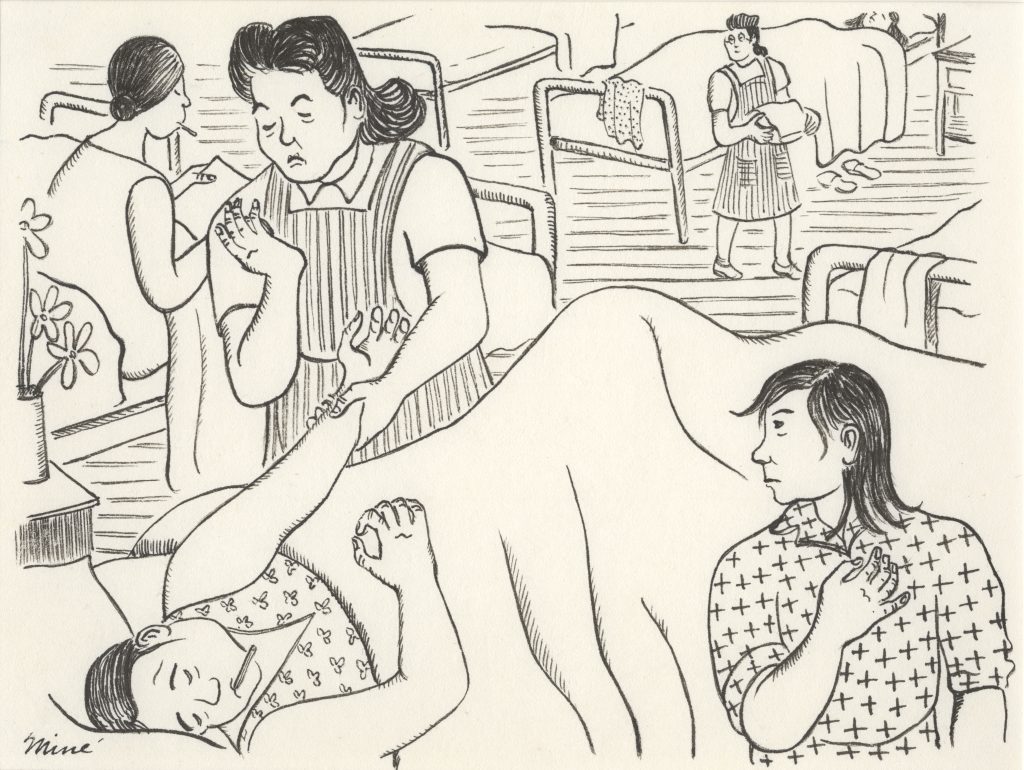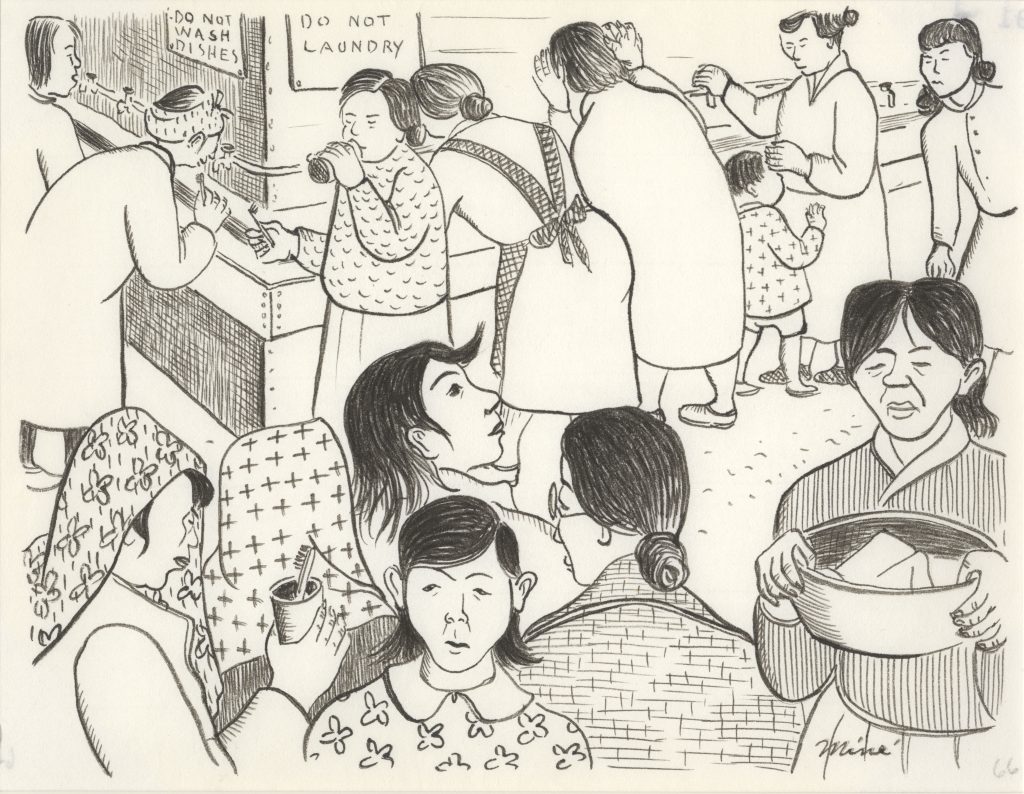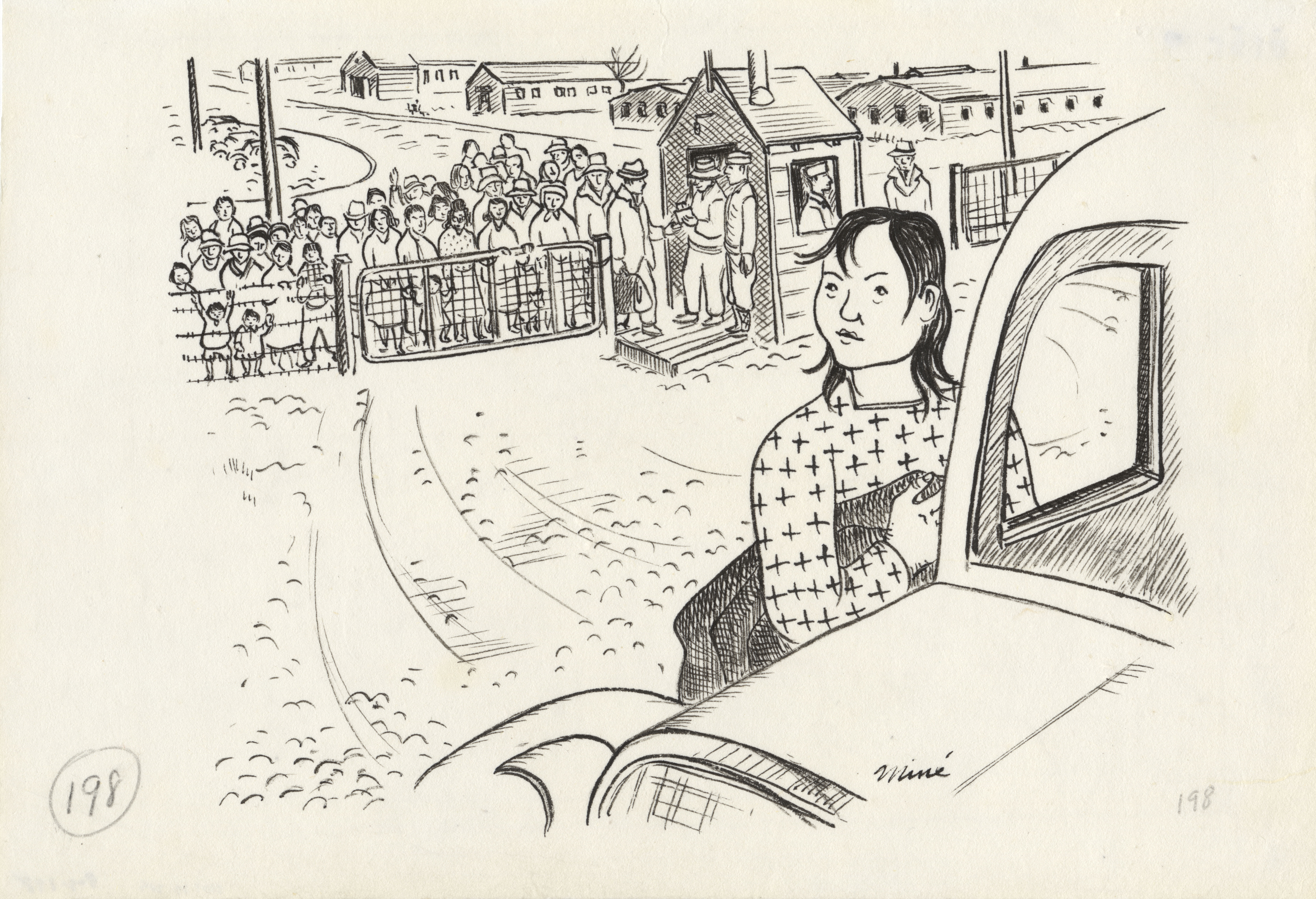Miné Okubo stands with hands resting on newspaper surrounded by anti-Japanese propaganda and epithets hanging in the air
1 drawing on paper : ink ; image 9.25 x 13 in., matted 16 x 20 in.
A woman, Mine Okubo, stands with hands resting on newspaper surrounded by anti-Japanese propaganda and epithets hanging in the air, California during World War II.
Japanese American National Museum (Gift of Mine Okubo Estate, 2007.62.14).
Miné Okubo stands in the room she shares with her brother Benji and a college student they met at camp
1 drawing on paper : ink ; image 9.25 x 13 in.
A woman, Mine Okubo, stands in profile in the left foreground of the room she shares with her brother Benji and a college student they met at camp.
Japanese American National Museum (Gift of Mine Okubo Estate, 2007.62.132)
Miné Okubo stands inside a camp hospital and watches as a nurse uses a stopwatch to time the pulse of an elderly woman
1 drawing on paper: ink ; image 9.75 x 14.5in.
A woman in a cross-patterned shirt, Mine Okubo, stands inside a camp hospital and watches from the right foreground as a nurse in a striped apron uses a stopwatch to time the pulse of an elderly woman who is lying in bed.
Japanese American National Museum (Gift of Mine Okubo Estate, 2007.62.161)
Miné Okubo stands among other women waiting for a space at troughs that served as wash basins in washrooms at Tanforan Assembly Center, California
1 drawing on paper : ink ; image 9.25 x 13 in., matted 16 x 20 in.
A woman with flipped forelock of hair, Mine Okubo, stands among other women waiting for a space at troughs that served as wash basins in washrooms at Tanforan Assembly Center, California during World War II.
Japanese American National Museum (Gift of Mine Okubo Estate, 2007.62.72)
Miné Okubo looks over her shoulder at a crowd gathered at the gate to bid farewell
1 drawing on paper : ink ; image 9.75 x 14.5 in.
A woman in a cross-patterned shirt, Mine Okubo, stands in the right midground and looks over her shoulder at a crowd gathered at the gate to bid farewell.
Japanese American National Museum (Gift of Mine Okubo Estate, 2007.62.205)
Background
Anti-Japanese attitudes had a long history in the United States, and grew significantly after the Japanese attack on Pearl Harbor in December 1941. In 1942, President Franklin Delano Roosevelt issued Executive Order 9066, which authorized the military to remove any person from a military area. The federal government defined the entire West Coast as a military area. It quickly relocated the 110,000 Japanese Americans living in that region to concentration camps built by the federal government in remote parts of the country. The government argued that all Japanese-born (Issei) and American-born (Nissei) residents of Japanese heritage posed a threat to national security. Most detainees were American citizens.
Life in the camps was traumatic. Families were often separated. Living conditions were basic and unsanitary. Communal bathrooms, straw-filled mats, and limited food reinforced the fact that the camps were prisons. Detainees worked hard to establish community and make life manageable. The government ran each camp like a miniature city. Detainees worked as doctors, nurses, teaches, shopkeepers, gardeners, and more. The number of potential employees outnumbered the available jobs, so many qualified men and women competed for the few opportunities for paid work.
The federal government went to great lengths to limit the general public’s knowledge about the camps. Government-hired photographers like Dorothea Lange were prohibited from publishing any photographs not approved by the government. The few images distributed by the government included smiling Japanese Americans who agreed to pose in the best possible conditions. Detainees were not even allowed to own or use cameras. By controlling photography, the government ensured that the truth behind the camps stayed a secret for as long as possible.
About the Image
These images were published by California-born artist Miné Okubo in her book Citizen 13660 in 1946. The title of the book comes from Miné’s government-issued family identification number. It was the first book about the American concentration camp experience written by a former prisoner. Miné hoped her book would shed light on the horrors of the Japanese American incarceration experience as the government moved to cover up much of the evidence. Miné was imprisoned from May 1942 through January 1944, first at the Tanforan temporary detention camp in California, and then the Topaz concentration camp in Utah. During her time in the camps, she drew over 2,000 illustrations. Two hundred of them were included in her book.
The first image shows Miné reading the newspaper and thinking about the increase of anti-Japanese attitudes following Pearl Harbor.
The second image shows Miné in her living quarters at Tanforan. She shared a room with her brother and a friend. Miné’s area was blocked off by the two blankets labeled “U.S.”
The third image shows Miné watching the operations of a camp hospital. Nursing was one of the few professional jobs available to female detainees. Women who worked as nurses before imprisonment competed for the few nursing jobs available at camp.
The fourth image shows Miné waiting in line to use one of the bathrooms communal sinks.
The fifth image shows Miné leaving the camp while others watch. The government occasionally allowed detainees to relocate outside the camps to attend college or take jobs. In 1944, editors at Fortune magazine learned about Miné’s illustrations and offered her a full-time job as an illustrator in the New York City offices.
Vocabulary
- concentration camp: A place where many political prisoners are forced to live, often under terrible conditions.
- Fortune magazine: A national business magazine.
- illustration: A drawing or picture that shows or demonstrates something.
- detainee: Someone imprisoned for political reasons.
- incarceration: imprisonment
- Issei: Japanese Americans who were born in Japan and emigrated to the United States.
- Nisei: First-generation Japanese Americans who were born in the United States to Japanese-born parents.
Discussion Questions
- How would you describe life in Japanese American concentration camps based on these images?
- What is happening in each image? How does each tell its own story? How does the set tell a larger story?
- Which image is most interesting to you and why? What do you learn about life for detainees from this image?
- What do these images tell you about the specific experiences of women in concentration camps? What challenges might they have faced as women?
- Why do you think Miné published her book? What might have been her goals? Why do you think so?
- How do you think Miné felt as a detainee? What evidence do you seen in her images to make you think that?
Suggested Activities
- Compare these images and the experience of Japanese Americans to the lives of non-Japanese Americans during the war, using any other materials in this section.
- Most Americans imprisoned under Executive Order 9066 were Japanese American, but not all of them. Learn about incarceration practices in New York that affected Italian and German residents in the WWII & NYC curriculum guide.
- Combine this illustration with the photograph of Japanese picture brides. Many picture brides were imprisoned in concentration camps. How do these images create a larger narrative about anti-Japanese sentiment in twentieth century America?
- Compare Miné’s work with that of Augusta Savage, another artist activist. How did each woman seek to change public opinion and educate other through their art?
Themes
AMERICAN IDENTITY AND CITIZENSHIP; POWER AND POLITICS











